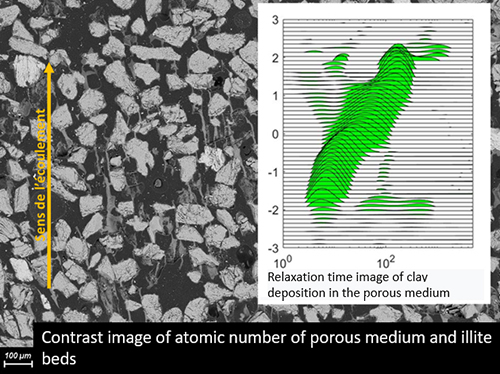Thesis prepared by Inès Raies: « Identification et compréhension des mécanismes de déstabilisation colloïdale dans les procédés géothermiques » ("Identification and understanding of colloidal destabilization mechanisms in geothermal processes")
In a porous geological structure, the flow of a geothermal fluid carries along solid particles for which the rock acts as a filter. The capture of these particles causes the permeability of the porous medium to gradually decrease, which can lead to a drastic reduction in injectivity and eventual failure of the industrial operation.
In order to gain a more detailed understanding of the mechanisms at work, the PhD research was structured around three priority areas [1, 2]:
- Identification of the clays that cause clogging;
- Study of clay stability under geothermal conditions;
- Study of the drop in injectivity caused by the deposition of clay particles in porous media.
A combined NMR and SEM approach was employed to better qualify the micrometric-scale alteration of the porous network and obtain the information required to interpret measured flow pressure losses, thereby improving the accuracy of the predictive numerical modeling of the phenomenon.
References
-
Formation damage induced by clay colloids deposition in Triassic clastic geothermal fields: Insights from an experimental approach, 2023, Raies Ines, Kohler Eric, Fleury Marc, Pédel Nicolas, Ledésert Béatrice, Applied Clay Science 234, 106868
>> DOI: https://doi.org/10.1016/j.clay.2023.106868
-
Clay-induced permeability decline in sandstone reservoirs: Insights from a coupled NMR-SEM experimental approach (2023) Raies Ines, Fleury Marc, Kohler Eric, Pédel Nicolas, Ledésert Béatrice, Geothermics 114, 102784
>> DOI: https://doi.org/10.1016/j.geothermics.2023.102784
Scientific contact: eric.kohler@ifpen.fr






